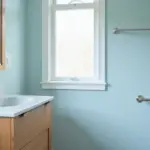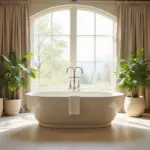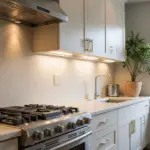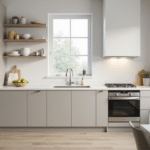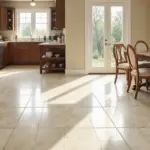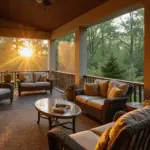Is your bathroom stuck in a time warp? In today’s homes, bathrooms are evolving from purely utilitarian spaces into personal sanctuaries. If you’re dreaming of a bathroom that’s both stylish and soothing, you’ve landed in the right spot.
I’ve curated 19 must-know bathroom design trends that can transform ordinary spaces into extraordinary retreats. From embracing nature’s beauty to indulging in high-tech comforts, get ready to discover the secrets to creating a bathroom you’ll truly love.
Let’s dive in and explore the trends that will elevate your bathroom into a haven of style and serenity.
1. Natural Materials Reign Supreme: Embrace Wood and Stone
The growing desire to connect with nature has propelled natural materials to the forefront of bathroom design trends. Wood and stone bring an inherent warmth and organic beauty, offering a welcome departure from the often sterile atmosphere of traditional bathrooms. This shift towards natural elements fosters a more spa-like ambiance, inviting a sense of calm into your daily routine.

When selecting natural materials for your bathroom, humidity and moisture resistance are crucial considerations. For wood, look to water-resistant species like teak, cedar, and bamboo. Stone options such as granite, marble, slate, and travertine each present unique aesthetics and varying maintenance needs. Consider your overall style goals and willingness to maintain these materials when making your selections.
“Creating a wood slat accent wall behind your vanity instantly transforms your bathroom into a modern, spa-like retreat.”
Here’s the catch: natural stone surfaces need regular sealing to prevent staining and water damage. Choose a sealant specifically designed for your stone type to ensure longevity.
As we embrace the tranquility of natural materials, let’s explore how to take this spa-like feeling even further by creating a true relaxation haven within your bathroom.
2. Transform Your Bathroom into a Spa Sanctuary: Focus on Relaxation
Creating a spa sanctuary at home is all about engaging the senses in ways that promote calm and well-being. This involves carefully curating elements such as soft, natural lighting, soothing color palettes dominated by muted greens, blues, and creams, and incorporating natural materials that ground the space. Comfortable textures, aromatherapy elements, and features that actively encourage relaxation—like soaking tubs and rainfall showerheads—all play vital roles in transforming your bathroom into a personal spa.

Even in compact bathrooms, creating a relaxing spa experience is entirely achievable. The key lies in maximizing space and minimizing clutter. Opt for lighter colors to visually expand the room, incorporate multi-functional storage solutions to keep surfaces uncluttered, and consider space-saving fixtures like wall-mounted sinks and toilets. A frameless shower door can contribute to a more open and airy feel, while small details like a heated towel warmer, a strategically placed plant, and a calming scent significantly elevate the sense of tranquility.
Key elements for a spa-like bathroom:
- Rainfall showerhead for an immersive experience
- Dimmer switches for customizable lighting
- Natural materials like bamboo and stone
- Plush, high-quality towels and bath mats
- Essential oil diffuser with calming scents
The breakthrough came when I realized that bathroom design trends aren’t just about aesthetics—they’re about creating experiences. From this relaxing sanctuary, let’s shift our focus to how cutting-edge technology is bringing your bathroom into the future.
3. Tech-Savvy Toilets: Smart Bidets and High-Tech Features
Modern smart toilets are packed with features designed to enhance hygiene, comfort, and convenience. Key features include integrated bidet functionality with adjustable water temperature, pressure, and nozzle positioning for personalized cleansing. Heated seats provide added comfort, especially during colder months, while automatic flushing systems offer hands-free operation. Additional features can include air dryers, deodorizers, nightlights for nighttime navigation, and even self-cleaning mechanisms to minimize maintenance.

Smart toilets revolutionize bathroom hygiene by replacing traditional toilet paper with a gentle, cleansing water stream, often followed by a warm air dryer. This method is not only more hygienic but also gentler on sensitive skin. The heated seat feature significantly enhances comfort, particularly on cold mornings. For individuals with mobility issues or certain medical conditions, the hands-free operation and enhanced hygiene of smart toilets can be particularly beneficial, promoting independence and well-being.
Do you see how huge that is? Before purchasing a smart toilet or bidet attachment, carefully measure your existing toilet and bathroom layout to ensure proper fit. Pay attention to water supply connections and electrical outlet access—these details make all the difference in a smooth installation.
Moving from the discreet technology of smart toilets, let’s shift our focus to a statement piece that brings undeniable luxury and elegance to your bathroom: the freestanding tub.
4. Indulge in Luxury with a Freestanding Tub: A Statement Piece
Freestanding tubs have become synonymous with bathroom luxury for several compelling reasons. Visually, they serve as striking focal points, instantly elevating the aesthetic appeal of any bathroom. Unlike built-in tubs, their standalone nature offers greater flexibility in placement, creating a sense of spaciousness and architectural interest. The often sculptural designs and premium materials used in freestanding tubs contribute to their luxurious feel, transforming the bathing experience into a ritual of indulgence.

Selecting the perfect freestanding tub requires careful consideration of several factors. Size and space are paramount; ensure the tub fits comfortably within your bathroom without overwhelming the area. Material choice impacts both aesthetics and maintenance—options include lightweight acrylic, cast iron for superior heat retention, copper for its unique aesthetic and antimicrobial properties, and modern stone resin. Style should harmonize with your bathroom’s overall design, ranging from classic clawfoot to sleek contemporary shapes. Plumbing is a crucial practical consideration, as freestanding tubs require floor-mounted or wall-mounted faucets, potentially necessitating plumbing adjustments.
What unfolded next was a revelation in bathroom design trends: creating a spa-like atmosphere around the freestanding tub with candles, aromatherapy diffusers, and soft lighting transforms an ordinary bath into an extraordinary experience.
From the captivating centerpiece of a freestanding tub, our gaze shifts upwards to another design element that can dramatically enhance both light and space in your bathroom: mirrors.
5. Mirror, Mirror on the Wall: Bold and Oversized Statement Mirrors
Oversized and bold mirrors are experiencing a surge in popularity due to their transformative impact on bathroom spaces. They’re incredibly effective at enhancing the sense of spaciousness, reflecting light to make even smaller bathrooms appear larger and brighter. Beyond their practical function, they serve as striking focal points, injecting personality and visual dynamism into the room. In essence, they transcend their utilitarian purpose, becoming works of art that elevate the overall design narrative of the bathroom.

Selecting an oversized statement mirror requires careful consideration of several design elements. The size of the bathroom is crucial; ensure the mirror is proportionate to the space, enhancing rather than overwhelming it. The style of the bathroom dictates the mirror’s frame—or lack thereof—to maintain design cohesion. Placement is key; consider what the mirror will reflect, aiming to amplify positive aspects and avoid unflattering angles or clutter. Lighting is paramount to maximize the mirror’s reflective properties and ensure it enhances the overall illumination of the space.
Let me paint you a picture: an oversized arched mirror above a double vanity creates a dramatic and elegant focal point, instantly transforming your bathroom’s vibe. Before purchasing, create a template out of cardboard to visualize its size and placement—this simple step prevents costly mistakes.
Having explored the impact of statement mirrors, let’s turn our attention to another powerful tool for transforming bathroom aesthetics: the bold use of color and pattern.
6. Dare to Go Bold: Embrace Vibrant Colors and Patterns
Introducing bold colors and patterns is a transformative strategy to elevate a bathroom from a purely functional space to a visually engaging and personality-rich sanctuary. It’s an opportunity to express your individual style and cultivate a unique atmosphere that invigorates the senses. Bold choices can inject life and energy into what is often an overlooked room, adding depth, dimension, and making even small bathrooms feel more spacious and intriguing.

There are myriad ways to infuse boldness into your bathroom design trends. A vibrant feature wall, achieved with richly colored paint, patterned wallpaper, or eye-catching tiles, is a highly effective approach. Bold vanity colors, such as deep blues, emerald greens, or even sunny yellows, can create a striking statement. Patterned flooring, whether through tiles, vinyl, or rugs, is another impactful way to introduce boldness underfoot. Accessories, including colorful towels, shower curtains, and artwork, further amplify the bold aesthetic, allowing for flexible and layered expressions of color and pattern.
The game-changer happened when I realized that color psychology influences our bathroom experience—blue evokes calmness, while yellow inspires energy and optimism. Start small by introducing bold colors through accessories before committing to larger elements.
While bold colors and patterns bring vibrancy, let’s explore the opposite end of the spectrum, delving into the allure of darker, more dramatic bathroom palettes.
7. Dive into Darkness: Moody and Dramatic Bathroom Palettes
A moody and dramatic bathroom palette intentionally moves away from the traditional light and airy aesthetic, embracing darker, richer hues to create a sense of intimacy and sophistication. Think deep charcoal grays, luxurious navy blues, lush forest greens, and even bold blacks as dominant colors. It’s not solely about the color itself, but about the interplay of light and shadow and the textures used within the space. This approach evokes a feeling of sanctuary and escape, transforming the bathroom into a cocoon of tranquility and style.

While a dark palette can be effectively implemented in bathrooms of any size, it requires careful consideration, particularly in smaller spaces. In smaller bathrooms, strategic use of dark colors is key. Consider limiting darker hues to accent walls or the vanity, balancing them with lighter elements like mirrors, bright fixtures, and well-planned lighting to prevent the space from feeling confined. Larger bathrooms offer more freedom to fully embrace darker palettes, but even then, proper lighting remains crucial to avoid a cave-like atmosphere.
The stumbling block is that dark colors can make a space feel smaller if not balanced properly. Test paint colors in your bathroom before committing—paint a large sample area and observe how the color changes throughout the day under different lighting conditions.
From the depths of moody palettes, let’s transition to a trend that brings life and freshness into the bathroom, connecting us with the natural world.
8. Bring the Outdoors In: Biophilic Design with Plants and Greenery
Biophilic design is a philosophy that seeks to strengthen the connection between building occupants and the natural environment. In bathrooms, this manifests as incorporating plants, maximizing natural light, and using natural materials like wood and stone. This bathroom design trend is gaining momentum because of the increasing awareness of its positive impact on well-being. Studies show it reduces stress and improves mood, making the bathroom—often a space for self-care—an ideal place to introduce these elements.
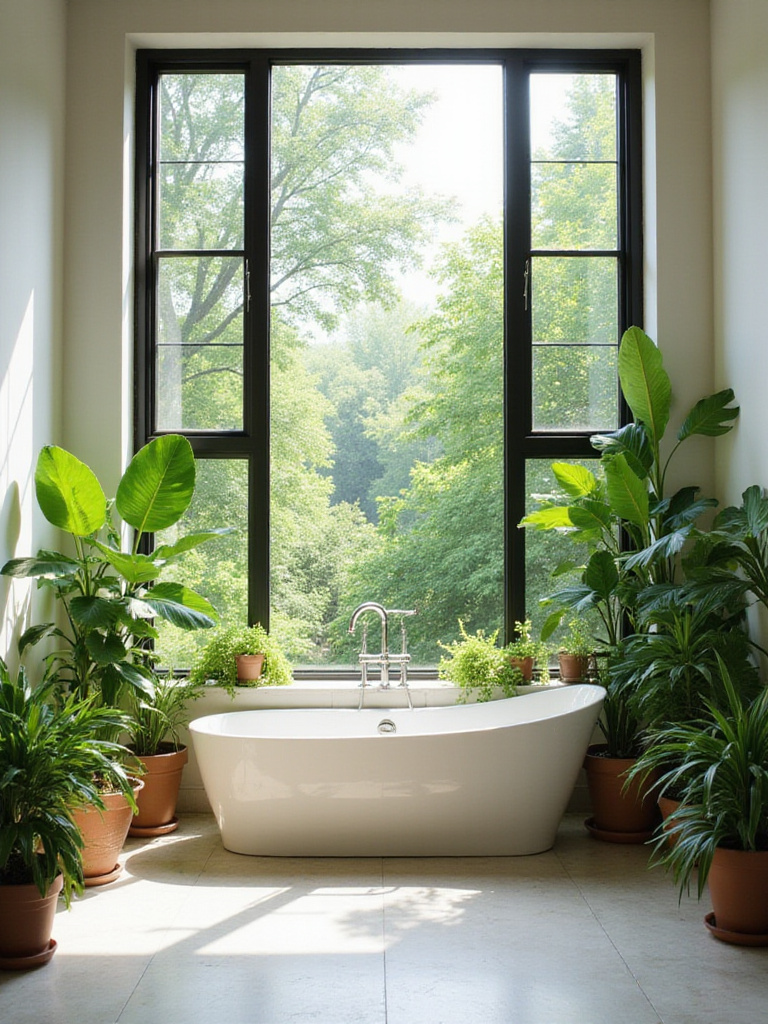
The ideal plants for bathrooms are those that flourish in humid and low-light conditions. Excellent choices include Snake Plants, known for their low-maintenance nature; ZZ Plants, another low-light champion; Pothos, easy to care for and visually appealing; Peace Lilies, which prefer shade and purify air; Air Plants, requiring no soil and versatile in display; Ferns, thriving in humidity; Orchids, adding elegance and tolerating humidity; and Aloe Vera, a succulent enjoying indirect light and known for its medicinal properties.
Best bathroom plants for humidity:
- Snake Plant (Sansevieria)
- Boston Fern
- Peace Lily
- Pothos
- Air Plants (Tillandsia)
It’s kinda like creating your own personal rainforest retreat—studies have shown that being around plants can lower blood pressure and reduce stress levels. Before purchasing plants, research their specific care requirements to ensure they’ll thrive in your bathroom’s unique environment.
From the vibrancy of biophilic design, we move towards a design philosophy that emphasizes simplicity and functionality: minimalism.
9. Less is More: The Enduring Appeal of Minimalist Bathrooms
A minimalist bathroom is defined by its clean lines, a predominantly neutral color palette, uncluttered surfaces, and a strong focus on functionality. Its enduring popularity stems from several key benefits. Firstly, it cultivates a sense of calm and tranquility, offering a peaceful retreat from the visual overload of daily life. Secondly, its simplicity makes it easier to clean and maintain, promoting hygiene and saving valuable time. Thirdly, minimalist design maximizes space, making even smaller bathrooms feel more expansive and open. Finally, it’s a timeless aesthetic that transcends fleeting trends, ensuring a lasting appeal.

Creating a successful minimalist bathroom design hinges on several key elements. Color is paramount; adhere to a neutral palette of whites, grays, beiges, and soft pastels to maintain a serene atmosphere. Choose high-quality materials with simple, clean lines, such as sleek tiles, frameless glass shower enclosures, and minimalist fixtures to enhance the understated elegance. Storage is crucial for maintaining clutter-free surfaces; integrate built-in cabinets, floating shelves, or mirrored cabinets to discreetly conceal toiletries and cleaning supplies. Lighting should be thoughtfully planned, combining natural light with soft, diffused artificial light to create a relaxing ambiance.
The missing piece is often ruthless editing—remove everything from your bathroom and only put back what you truly need and use regularly. Store the rest elsewhere to maintain the clean, open feel that makes minimalist bathroom design trends so appealing.
While minimalism focuses on simplicity, let’s explore how adding texture can enrich a bathroom’s visual and tactile experience.
10. Texture Talk: Add Depth with Textured Walls and Tiles
Texture is a vital element in bathroom design trends, adding crucial visual interest and depth to spaces that can often feel sterile due to the prevalence of smooth, hard surfaces. Introducing texture creates a more layered, inviting, and visually stimulating environment. It breaks up monotony, adding a tactile dimension that appeals to both sight and touch, enhancing the overall sensory experience of the bathroom. Furthermore, texture can subtly influence the perceived size and warmth of the room, making it feel more intimate and inviting.

A wide array of textured tile options are available to add depth and character to bathroom walls and floors. Stone-look tiles replicate the natural beauty of stone with varied depths and surface textures, offering both rustic and modern aesthetics. Wood-look tiles provide the warmth of wood with the durability and water resistance of tile, often featuring realistic grain patterns and subtle imperfections. 3D tiles incorporate raised patterns, geometric shapes, or sculpted designs, creating dynamic and eye-catching effects. Zellige tiles, handmade Moroccan tiles, exhibit inherent variations in color, texture, and size, adding unique artisanal character.
Here’s where everything changes: creating a feature wall behind the vanity using bold, textured tile draws the eye and adds a focal point that transforms your entire bathroom’s feel. Before committing to a textured wall treatment, obtain samples and test them in your space to see how they interact with your lighting and other elements.
From the tactile appeal of texture, let’s turn our attention to adding a touch of opulence with metallic finishes, specifically brass and gold.
11. Golden Glamour: Brass and Gold Fixtures for a Touch of Luxe
While both brass and gold finishes impart a sense of luxury to bathroom design trends, they differ distinctly in composition and appearance. Brass, an alloy of copper and zinc, offers a range of shades from antique to polished, typically presenting a warmer, more muted luster. Gold finishes, often plated over other metals, are generally brighter and more reflective, evoking a more contemporary and opulent feel. The choice between brass and gold hinges on the desired aesthetic and the bathroom’s overall color palette. Brass tends to lend a warmer, vintage-inspired touch, while gold offers a more modern, glamorous vibe.

Brass and gold finishes can elevate a wide variety of bathroom fixtures and hardware. Faucets, showerheads, towel bars, cabinet hardware, lighting fixtures, and even mirror frames are excellent candidates for these luxurious finishes. For a cohesive and impactful look, consider carrying the chosen finish throughout these elements. However, strategic placement is key; avoid over-saturation. Well-placed gold or brass accents, such as a striking gold faucet against a dark countertop, can create a more dramatic and sophisticated focal point than covering every surface in metallic finishes.
My breakthrough came when I discovered that starting small makes a big difference—begin by replacing cabinet hardware with brass or gold options to test the look before committing to larger fixtures. This approach lets you experiment with these luxurious bathroom design trends without breaking the bank.
Having explored the allure of metallic accents, let’s shift our focus to tile size, specifically the growing trend of large format tiles.
12. Go Big or Go Home: Large Format Tiles for Seamless Style
Large format tiles are characterized by their significantly larger dimensions compared to traditional tiles. While no definitive size standard exists, tiles typically considered “large format” begin around 12×24 inches and can extend to sizes like 24×48 inches, 36×72 inches, or even larger slabs capable of covering entire walls. The defining characteristic is their substantial size relative to standard square or rectangular tiles, minimizing grout lines and creating a more expansive visual effect in modern bathroom design trends.

Large format tiles offer a compelling combination of aesthetic and practical advantages in bathrooms. Aesthetically, they create a cleaner, more modern, and seamless appearance due to the reduced number of grout lines. This visual continuity expands the perception of space, making even smaller bathrooms feel larger and more open. Practically, fewer grout lines translate to less maintenance and easier cleaning, as there are fewer areas for dirt and grime to accumulate. Furthermore, the expansive scale of large format tiles imparts a higher-end, luxurious feel to the bathroom.
The tricky part is installation—before installing large format tiles, thoroughly inspect and level the subfloor to ensure a smooth and even surface. Uneven surfaces can lead to cracking or lippage (where one tile edge is higher than its neighbor), ruining the seamless look you’re trying to achieve.
From the expansive feel of large format tiles, we move to another design element that enhances the sense of spaciousness and modernity: floating vanities.
13. Float Away: The Modern Elegance of Floating Vanities
Floating vanities offer a compelling array of benefits that enhance both the aesthetics and functionality of bathroom design trends. Primarily, they create the illusion of increased space, making even smaller bathrooms feel larger and more airy. This sense of openness is achieved by exposing the floor space beneath the vanity, visually expanding the room. Cleaning becomes significantly easier; the open space beneath eliminates hard-to-reach areas around the base of traditional vanities. Floating vanities embody a modern and minimalist aesthetic, instantly elevating the style quotient of your bathroom. Finally, they offer customization in installation height, making them ergonomically adaptable.

Floating vanities are available in a diverse range of styles and materials to complement any design vision. Stylistically, options span from sleek, minimalist designs characterized by clean lines to more rustic iterations incorporating reclaimed wood for a warmer, textured appeal. Material choices are equally varied, including natural woods like oak, walnut, maple, and teak; engineered woods such as MDF and plywood; stone options like marble, granite, and quartz; and even industrial-chic metal. The selected material profoundly influences the vanity’s overall look and feel, as well as its durability and maintenance demands.
Picture it this way: incorporating LED strip lighting underneath the floating vanity creates a soft, ambient glow that further enhances the floating effect—it’s like your vanity is hovering in mid-air, adding a magical quality to your bathroom.
While floating vanities offer concealed storage, let’s explore the beauty and functionality of open shelving for displaying bathroom essentials and décor.
14. Display Your Style: Open Shelving for Functional Decor
Open shelving is increasingly favored in bathroom design trends for its blend of visual appeal and practical storage. It provides an opportunity to showcase personal style through thoughtfully curated items, adding warmth and individuality to the often utilitarian bathroom environment. Compared to bulky closed cabinets, open shelving fosters a sense of spaciousness and airiness, contributing to a more open and inviting atmosphere. It allows for easy access to frequently used items while also serving as a display for decorative elements.

Planning open shelving effectively in a bathroom requires careful consideration of several factors. Material selection is crucial; opt for moisture-resistant materials such as sealed solid wood, treated plywood, glass, or metal to withstand bathroom humidity. Avoid MDF or particleboard, which are susceptible to water damage. Shelf placement should be strategic, considering plumbing, lighting, and accessibility to ensure shelves are both functional and visually harmonious. Weight capacity is important; ensure shelves are robust enough to support intended items, using appropriate brackets and mounting hardware.
The heart of the matter is finding the right balance between display and function. Incorporate a mix of shelf depths to accommodate items of varying sizes—deeper shelves for towels and shallower shelves for decorative items. This creates visual interest while maximizing utility in your bathroom design.
From open shelving and visual display, we transition to a trend that redefines the shower experience and bathroom layout: wet rooms and open showers.
15. Seamless Style: The Rise of Wet Rooms and Open Showers
While both wet rooms and open showers emphasize a seamless and spacious bathroom design trend, their primary distinction lies in the extent of waterproofing and overall layout. A wet room is essentially an entire bathroom that is fully waterproofed, allowing the shower area to merge seamlessly with the rest of the space. It typically features a single, sloped floor leading to a drain and may include a partial glass screen or remain completely open. An open shower, conversely, is a shower area without a door or full enclosure, but the rest of the bathroom may not be fully waterproofed. Open showers often incorporate a low curb or subtle flooring transition to define the shower space and contain water.

The advantages of wet rooms and open showers are numerous and encompass both aesthetic and functional aspects. Aesthetically, they create a modern, minimalist, and spa-like ambiance, characterized by clean lines and a sense of openness. Functionally, they enhance accessibility, particularly beneficial for individuals with mobility limitations, eliminating thresholds and enclosures. They can make smaller bathrooms feel significantly larger and more open, maximizing the perceived space. Cleaning is often simplified due to fewer enclosures and corners. Furthermore, the luxurious and modern appeal of wet rooms and open showers can potentially increase a home’s resale value.
The crucial element is impeccable waterproofing and drainage—incorporate a linear drain along the wall for a sleek and minimalist look, maximizing drainage efficiency. Always consult with a qualified contractor specializing in wet room construction to ensure proper waterproofing and prevent costly water damage.
From the seamless flow of wet rooms, let’s focus on another element that promotes a smooth and integrated design aesthetic: integrated sinks.
16. Smooth and Sleek: Integrated Sinks for a Modern Look
Integrated sinks are designed to form a seamless, continuous surface with the countertop, typically crafted from the same material. Unlike traditional sinks that are installed as separate units—drop-in, undermount, or vessel-style—integrated sinks eliminate seams and joins at the countertop edge. This creates a cleaner, more streamlined, and modern aesthetic, minimizing areas where dirt and grime can accumulate. They are often molded directly into the countertop material, resulting in a single, unified piece that enhances the visual flow and simplifies cleaning.

Integrated sinks offer a compelling set of benefits in bathroom design trends, primarily centered around ease of maintenance and aesthetic appeal. Their seamless design makes them exceptionally easy to clean, eliminating crevices where dirt and mildew can collect. They provide a streamlined, minimalist look that perfectly complements contemporary bathroom designs, enhancing the overall sense of sophistication. Integrated sinks offer customization in shape, size, and color, allowing for a perfect match with the countertop and the bathroom’s overall design scheme. Furthermore, when crafted from high-quality materials, they offer a durable and long-lasting solution.
You might be wondering about practicality—when planning an integrated sink, carefully consider the countertop height and depth to ensure ergonomic comfort during use. The subtle slopes for efficient water drainage add not just functionality but also visual interest to your bathroom design.
While integrated sinks embrace modern sleekness, let’s look back in time, celebrating the charm and elegance of vintage-inspired fixtures and details.
17. Timeless Charm: Vintage-Inspired Fixtures and Details
Vintage-inspired bathroom design trends are characterized by a blend of classic silhouettes, intricate details, and an emphasis on quality craftsmanship, reminiscent of bygone eras. Key elements often include clawfoot tubs as focal points, pedestal sinks for their elegant simplicity, high-tank toilets that evoke historical charm, cross-handle faucets with traditional detailing, and patterned tilework such as subway or mosaic tiles. Color palettes typically lean towards softer, more muted hues, like creams, whites, pastels, and muted jewel tones, creating a sense of understated elegance. The overall aesthetic aims to evoke a feeling of history, sophistication, and comfortable familiarity.

The art of incorporating vintage elements lies in achieving balance and avoiding a purely period-specific recreation that can feel dated. The key is to selectively choose a few key vintage-inspired pieces and skillfully blend them with modern elements to create a layered and timeless aesthetic. For example, pairing a vintage-style pedestal sink with a sleek, frameless mirror and contemporary lighting creates an intriguing juxtaposition. Alternatively, installing classic subway tile but using a bolder grout color or a modern layout can provide a fresh twist on a traditional element. Mixing and matching vintage and modern elements creates a sophisticated, personalized look that feels both timeless and current.
My experience went like this: I installed a clawfoot tub as a focal point, paired with a vintage-style faucet and exposed plumbing, but kept the rest of the bathroom contemporary. The contrast created a unique space that felt both nostalgic and fresh—a perfect balance for modern bathroom design trends.
From the timeless appeal of vintage design, let’s turn to a trend that brings playful energy and visual interest through geometric patterns.
18. Geometry is Groovy: Playful Geometric Patterns in Tiles and Decor
Geometric patterns are a trending choice for bathroom design because they introduce a visually engaging and dynamic element. Their versatility allows them to range from subtle and sophisticated to boldly playful, offering opportunities for personalization and adding unique character to the bathroom space. Geometric patterns are adaptable to various design styles, from modern minimalist to retro and art deco influences, making them a flexible design tool. They also provide a structured and impactful way to introduce color, texture, and visual interest, transforming otherwise plain surfaces into focal points.

Popular geometric shapes in bathroom design trends include hexagons, triangles, chevrons, and squares, along with more complex tessellations for intricate patterns. Arrangements range from repeating patterns covering entire walls or floors to strategically placed accents in backsplashes, shower niches, or decorative borders. Herringbone and basketweave patterns are also gaining popularity for their classic yet dynamic appeal. Creative mixing of different sizes and colors of the same geometric shape can further personalize designs, creating unique and visually captivating surfaces.
Think of it as adding personality through pattern—create a focal point with a geometric tile backsplash behind the vanity. Before committing to a geometric tile pattern, create a mockup or use online design tools to visualize the finished result. This small step can save you from pattern regret!
Finally, as we explore these bathroom design trends, the ultimate goal is to create a space that is not only stylish but also uniquely yours, reflecting your personal tastes and needs.
19. Make it Yours: Personalized Touches and Customization Options
Personalization is paramount in bathroom design trends because it transforms a purely functional space into a personal sanctuary that truly reflects your individual style and caters to your specific needs. It transcends mere aesthetics, focusing on creating an environment that promotes personal well-being and comfort. A bathroom imbued with personal touches becomes a daily reminder of your values and preferences, contributing to a more positive and relaxing experience every time you use the space. Ultimately, personalization elevates a bathroom from generic to genuinely yours.

Ways to personalize your bathroom: – Gallery wall of framed prints or photographs – Custom-built storage solutions for your specific needs – Monogrammed towels and accessories – Unique hardware that reflects your style – Personal collection displays (sea shells, vintage perfume bottles, etc.)
Perhaps you’ve already guessed that the most successful bathroom design trends are those that speak to your personal style while remaining functional for your daily needs. Start by identifying what matters most to you—whether it’s luxury, efficiency, sustainability, or comfort—and build your design around those priorities.
Conclusion
From embracing the serenity of natural materials to indulging in the luxury of freestanding tubs and tech-savvy toilets, these 19 bathroom design trends offer a diverse palette for creating your dream space. Whether you’re drawn to the bold drama of dark palettes and geometric patterns, the timeless elegance of vintage-inspired details, or the sleek simplicity of minimalism and integrated sinks, the key is creating a bathroom that resonates with your personal style.
Remember to blend functionality with aesthetics, and don’t be afraid to infuse your own personality into the design. By incorporating these bathroom design trends thoughtfully, you can transform your space into a true sanctuary—one that not only meets your needs but elevates your everyday experience.
Take inspiration from these trends and embark on your journey to create a bathroom you’ll love for years to come. After all, in a room where you both start and end your day, shouldn’t every detail be just right?

